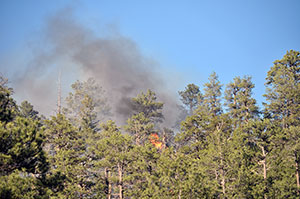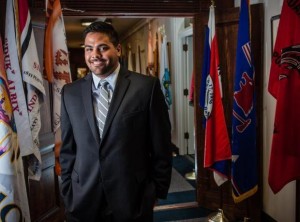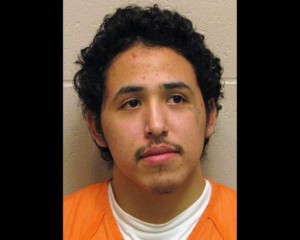By Alastair Lee Bitsoi and Terry Bowman, Navajo Times
After three days of charring approximately 1,000 acres, the Asááyi Lake Fire has reached the summit of the Chuska Mountains and the inferno is moving in a northeastern direction toward the communities of Naschitti and Sheep Springs, N.M.
The fire will be categorized as a Type II National and State Level Fire, according to the Southwest Area Incident Management Team.
“I got scared,” said Eleanor Largo, who had to evacuate her summer sheep camp near the area locals call Green Meadows.
Green Meadows, which is about 11 miles west of Naschitti, is on the part of the Chuska Mountains known as Biita’dah in Navajo. It’s a region of the mountain where locals have summer camps, and consists of canopies of pinion, juniper and pine trees.
Largo reported to the Navajo Times Sunday night that the fire was north of her summer residence, before she was told by fire officials to depart the mountain. She left her dog and cat behind and sought refuge at the command center and shelter in Naschitti.
“My daughter was crying,” she added, while wiping away tears from her face and having her vitals checked by a first responder.
“Sparks were going toward my house,” she added.
More than 250 firefighters from Bureau of Indian Affairs, including the Navajo Scouts and Navajo Hotshots are battling the blaze. They are being assisted by the Navajo Volunteer Fire Department and the Helitrack Crew.
Fire crews from all over the Navajo Nation and Southwest region of the U.S. are also helping manage the blaze.
According to the Southwest Area Incident Management Team, about close to 1,000 acres have been consumed by the fire that started Friday afternoon north of Asááyi Lake in Crystal, NM.
Dangerous high winds reaching to up to 60 mph in the Chuska Mountains have played a key role in keeping the fire alive.
In response to the growing fire, emergency management centers have been set up at Crystal and Naschitti Chapter Houses.
Once seeing the fire reach the summit and moving down from Biighaadi, the very top of the mountain, Gloria Dennison, of Naschitti, knew the fire was “very serious.”

“Some people left their livestock up there,” she said.
She added that the way fire has shifted with the wind is scary.
“This is not going to stop because of the wind,” the former chapter president said.
Melvin Stevens, a community member and president of the Authorized Local Emergency Response Team in Naschitti, said that the fire is between Whiskey Lake and Sand Springs, N.M., an area where locals also have summer sheep camps.
There is “heavy smoke and flames,” Steven said, adding that the fire has also moved down from the summit, or Biighaadi, to the region of the mountain known as Biita’dah.
“We’re trying to get organized to get people off of the mountain and keep them away from where the fire is at,” Stevens said.
“You can see the flames on our side of the mountain,” Steven said, adding, “This is one of the largest fires we had and its pretty dry up there.”
Residents are advised to stay out of the Crystal/ Asááyi Lake area. Highway 31 from Crystal to Sheep Springs is closed, as well as Highway 30 going to Mexican Springs. Route 321 coming down from Crystal Chapter to Asááyi Lake is also closed.
People are asked by the SWA Incident Management Team to avoid these roads because the dangers of the fire and the unnecessary traffic for fire crews.
 The cause of the fire is still unknown at this time, and authorities aren’t ruling out the possibility of it being human caused, said Regional Fire Management Officer Dale Glenmore, who added the fire is currently being investigated by Navajo Nation authorities.
The cause of the fire is still unknown at this time, and authorities aren’t ruling out the possibility of it being human caused, said Regional Fire Management Officer Dale Glenmore, who added the fire is currently being investigated by Navajo Nation authorities.
Glenmore, who briefed fire crews at the SWA Incident Management Team command center at Navajo Nation Museum in Window Rock Sunday afternoon, explained that fire crews from Zuni, Fort Apache, Black Mesa, Mount Taylor, Prescott, Morman Lake, Globe and Blue Ridge are fighting the blaze.
The Southwest Region Team 3 will take over control of fire operations Monday morning. The fire crews will began work at 6 a.m. according to a Bea Day, Instinct Commander of the Southwest Region Team 3.
For more info, call the Bureau of Indian Affairs Division of Forestry and Wildland Fire Management (928)729-23007 or the Navajo Nation Police Department (928) 871-6111.









 Nanuqsaurus, the North’s new “pygmy” dinosaur, was announced to much hoopla this spring, when fragments from a 2006 excavation in Alaska were identified in a recent report as a separate, smaller Tyrannosaurus species. But not much smaller. Despite the fact that Nanuqsaurus was a) half the size of his regal relatives, and b) likely covered in a coat of downy feathers, the 70-million-year-old reptile was still six metres from head to toe, able to comfortably snack on even the largest modern polar bear.
Nanuqsaurus, the North’s new “pygmy” dinosaur, was announced to much hoopla this spring, when fragments from a 2006 excavation in Alaska were identified in a recent report as a separate, smaller Tyrannosaurus species. But not much smaller. Despite the fact that Nanuqsaurus was a) half the size of his regal relatives, and b) likely covered in a coat of downy feathers, the 70-million-year-old reptile was still six metres from head to toe, able to comfortably snack on even the largest modern polar bear.





